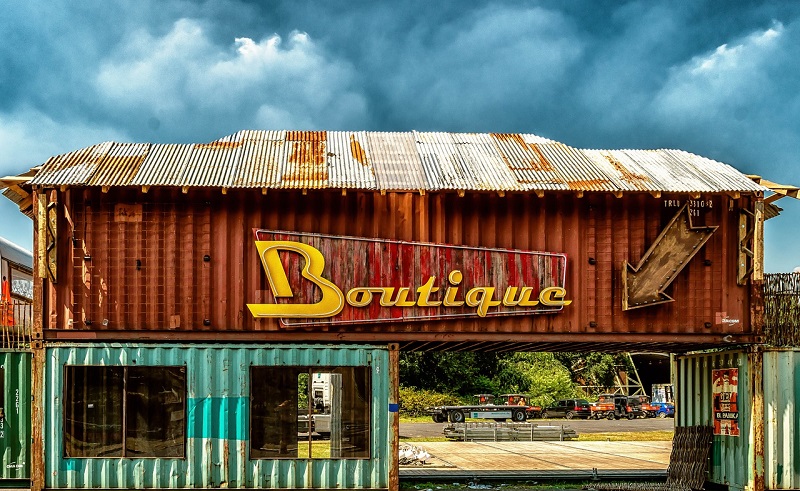Crinkly tin

|
| The roof of this small building made of old shipping containers is clad with a sinusoidal profile steel sheet. |
[edit] Introduction
‘Crinkly tin’ refers to sheets of profiled steel that are used for roofing and cladding buildings, mostly in industrial and other applications. The term is actually a misnomer as the sheeting is generally not made of tin. Today, the material mostly goes under the name of ‘profiled sheeting’, but may also be referred to as ‘wiggly’ or ‘wriggly’ tin, ‘corrugated iron’ or ‘galvanised sheets’.
Invented in 1829 as corrugated iron sheeting, the material was used in the late nineteenth century for building pre-fabricated buildings that were transported throughout the British Empire. It also became popular for agricultural sheds. Architects eventually found the material to be functional, durable, relatively economic, fast to install and with a potentially attractive ribbed texture and thus it came to be applied to numerous more permanent building types
Today, ‘crinkly tin’ is mainly made from galvanised or plastic-coated steel and is applied to elevations and roofs on a range of buildings that include warehouses, agricultural sheds, retail and industrial units, colleges and hospitals.
Specifiers can choose from a plethora of sheet types that are differentiated by their profile e.g trapezoidal or sinusoidal, pitch, thickness and colour. Sheets are also available that emulate roof tiles and pantiles at a fraction of the cost.
Generally used as a single skin, sheets for roofs are typically 0.7mm gauge and for walls 0.5mm gauge. Due to its thermal properties, condensation may occur either behind or below the sheeting. To avoid this, construction may incorporate insulation and vapour barriers.
[edit] Potential problems
It is common for steel sheeting to be coated with a very thin plastic layer to give protection against corrosion. However, this coating may be compromised on site when the material is cut to size, as the freshly cut edge will have no coating. The result is corrosion at the bare steel edge, and this will be exacerbated by rain and pollutants. Once corrosion starts, it can spread from the edges to other areas. Cut-edge corrosion is typically found at the eaves and sheet overlaps.
Corrosion may also occur when the metal expands in hot weather as the plastic coating may detach and allow water to penetrate. The ensuing corrosion may cause leaks and even perforation of the metal.
[edit] Related articles on Designing Buildings
Featured articles and news
Construction Skills Mission Board launch sector drive
Newly formed government and industry collaboration set strategy for recruiting an additional 100,000 construction workers a year.
New Architects Code comes into effect in September 2025
ARB Architects Code of Conduct and Practice available with ongoing consultation regarding guidance.
Welsh Skills Body (Medr) launches ambitious plan
The new skills body brings together funding and regulation of tertiary education and research for the devolved nation.
Paul Gandy FCIOB announced as next CIOB President
Former Tilbury Douglas CEO takes helm.
UK Infrastructure: A 10 Year Strategy. In brief with reactions
With the National Infrastructure and Service Transformation Authority (NISTA).
Ebenezer Howard: inventor of the garden city. Book review.
The Grenfell Tower fire, eight years on
A time to pause and reflect as Dubai tower block fire reported just before anniversary.
Airtightness Topic Guide BSRIA TG 27/2025
Explaining the basics of airtightness, what it is, why it's important, when it's required and how it's carried out.
Construction contract awards hit lowest point of 2025
Plummeting for second consecutive month, intensifying concerns for housing and infrastructure goals.
Understanding Mental Health in the Built Environment 2025
Examining the state of mental health in construction, shedding light on levels of stress, anxiety and depression.
The benefits of engaging with insulation manufacturers
When considering ground floor constructions.
Lighting Industry endorses Blueprint for Electrification
The Lighting Industry Association fully supports the ECA Blueprint as a timely, urgent call to action.
BSRIA Sentinel Clerk of Works Training Case Study
Strengthening expertise to enhance service delivery with integrated cutting-edge industry knowledge.
Impact report from the Supply Chain Sustainability School
Free sustainability skills, training and support delivered to thousands of UK companies to help cut carbon.
The Building Safety Forum at the Installershow 2025
With speakers confirmed for 24 June as part of Building Safety Week.
The UK’s largest air pollution campaign.
Future Homes Standard, now includes solar, but what else?
Will the new standard, due to in the Autumn, go far enough in terms of performance ?
BSRIA Briefing: Cleaner Air, Better tomorrow
A look back at issues relating to inside and outside air quality, discussed during the BSRIA briefing in 2023.
Restoring Abbotsford's hothouse
Bringing the writer Walter Scott's garden to life.
Reflections on the spending review with CIAT.

























